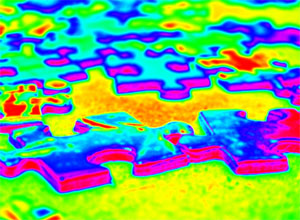
Autism
Unlike tuberculosis and polio, two infectious diseases that were nearly eradicated in the twentieth century as a result of scientific advances, many neurological disorders are actually on the rise. One prominent example is autism, a disorder that results in difficulty with communication and social interaction. According to a study published in the journal Pediatrics in 2009, the rate of autism among children is now 1 in 100, more than double the rate assessed in the mid-1990s. This striking growth has renewed public dialogue about the causes of autism and the subjectivity of its diagnosis.
For many decades, autism was considered to have purely psychological origins. Dr. Bruno Bettelheim, a psychologist at the University of Chicago and survivor of the Dachau concentration camp, believed that circumstances of severe deprivation are the basis of severe emotional disturbance. Consequently, through his work with children, he concluded that the emotional disorder now known as autism is a psychotic disturbance caused by maternal neglect. Due in part to Bettelheim's influence, the notion that autism is caused by environmental factors rather than biological factors became widespread during the 1950s and 1960s. However, in 1964 Dr. Bernard Rimland, a psychologist and the father of an autistic child, showed through analysis of data gathered from twins that the occurrence of autism has a strong genetic basis, and is not linked to maternal behavior. His work shifted the focus of blame from so-called "refrigerator" mothers, and launched a vigorous new era of research into the biological basis of autism.
Research has now associated as many as fifteen genes with autism, most of which support the strength of connections between different areas of the brain. According to this research, none of the relevant genes are absent or mutated in an autistic person, but their expression levels vary from expected norms. This results in an abnormally functioning nervous system characterized by poor brain connectivity that causes impaired social behavior and communication.
Recently, the scientific community has developed a more nuanced understanding of autism's origins that takes both biological and environmental causes into account. Advances in the field of epigenetics, in particular, show that environmental interaction with genes can modulate neurological functioning. Intense research is underway today in genetics, neuroscience, psychology, and even nutrition studies to refine our understanding of autism's origins and settle the question of why the rate of autism has grown so much during the past twenty years.
There is another intriguing possibility to consider that involves the work of social scientists: what if it is not the rate of occurrence but the rate of diagnosis of autism that has increased? Physicians and parents are now more aware of the disorder and its symptoms than they were before, and the standards for diagnosis have changed over time. In the mass media, for instance, classical autism proper is often conflated with Autism Spectrum Disorders (ASDs), a broad grouping of disorders characterized by milder forms of impaired language development, social interaction, and motor skills than classical autism. Two of the more familiar ASDs are Pervasive Developmental Disorder-Not Otherwise Specified (PDD-NOS) and Asperger's syndrome. Would these shadow syndromes have been considered autism in the mid-nineties? The American Psychological Association recently announced, for instance, that it is again reviewing the terminology that distinguishes Asperger's syndrome and other ASDs from autism, illustrating how changing standards of diagnosis over time might factor into the growth of autism rates.
Opinions about the best treatments for autism have been as varied as about its origins. Some treatments — Applied Behavioral Therapy, Pivotal Response Therapy, and Verbal Therapy, for instance — are purely behavioral, in that they reinforce desired behaviors with consistent rewards, to develop a patient's social abilities. Other treatments involve pharmaceuticals or special nutritional approaches. Opinions about the best treatment for autism are as complex and changing as the research about its causes.
Popular impressions of autism have been largely shaped by mass media. Dustin Hoffman's Oscar-winning performance as an autistic savant (someone whose social impairment is combined with exceptionally high computational or other intellectual abilities) brought autism into public discussion in 1988. Claire Danes's current performance in an HBO movie as Temple Grandin, an animal scientist who used her autistic sensitivity to develop improved techniques of animal handling in the agricultural industry, presents an even more nuanced and accurate depiction of the experience of an autistic person.
We hope that many people will use Temple Grandin and other mass-media discussions of autism as starting points for learning about the neurological basis of the disorder and its treatment. In this Spotlight, we guide you through the basics of autism, the context for understanding diagnosis rates, and the culture surrounding autistic people and their caretakers.
Image by Kevin Fruet.
What is autism?
Read answers to the most basic questions about autism.
Go here to learn more about the criteria used to diagnose autistic individuals.
NIMH offers resources about the signs and symptoms of ASD.
Treatments for autism
A double-blind clinical trial found that severe behavioral disturbances in autistic children can be alleviated with the drug risperidone.
The most widely accepted behavioral treatment for autism is Applied Behavioral Analysis (ABA), developed by Dr. Ivar Lovaas.
NAMI explains resources for adults who have less severe autism, and fall on the autism spectrum.
Read how despite opposition a new wave of activists wants to celebrate atypical brain function as a positive identity, not a disability.
Spurred by an elevated national focus on finding a cure for autism, many autistic individuals argue that they're not suffering from a disease.
One symptom of autism is a "deficiency" in using conventional forms of language. See how autism can teach us to reconsider communication.
Discover how one entrepreneur is recruiting autistic employees, who are better suited to tasks requiring intense concentration and recall.
A recent HBO biopic celebrates the achievements of Dr. Temple Grandin, an autistic woman who revolutionized the cattle industry.
Listen to Dr. Grandin as she discusses the sensory experience of autism as well as the relationship between autism and science.
Facts and Figures about Autism
See the latest figures compiled by the CDC, grouped by state.
Caring for a single autistic child places a significant financial strain on parents.
See a current list of clinical trials focused on autism that may soon yield results.
Autism and vaccines
Despite lack of evidence, child-vaccine opponents have singled out this additive.
Read the CDC's stance on the link between autism and vaccinations.
The Lancet's retraction of a 1998 study followed an ethics investigation.






























